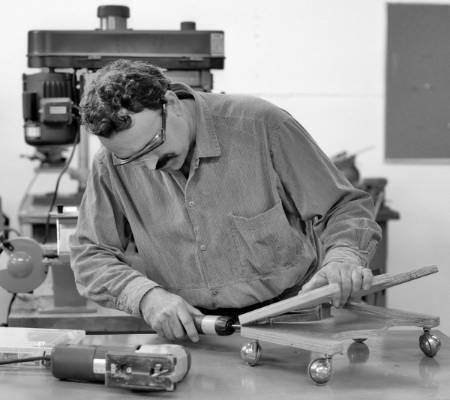Assistive Technology Comes Full Circle With Donated Walker

Rick Escobar first came to Utah State University on unfinished business: he wanted to complete a degree in agricultural systems technology, after an injury interrupted his schooling. At USU he heard about assistive technology, took a class, and was hooked.
That interest set him on a life-changing career path that went from helping develop the assistive technology lab at USU to acquiring an AT patent (another one is currently in the works). He also founded an AT design company. This summer, Escobar brought a donation to the CPD’s Up to 3 program that can help a child walk hands-free for the first time. He is the Kidwalk gait trainer’s co-inventor.
It all started in the 1990s, when Escobar was the first director of the assistive technology lab at the Center for Persons with Disabilities at Utah State University. He teamed up with Richard Baer to develop an interdisciplinary AT course. Beth Foley and Amy Henningsen were the lead faculty. The assistive technology fabrication lab, as it was called then, was founded during a wave of interest in assistive technology. Wheelchairs and other adaptive devices had existed for a long time. However with the advances in computer technology in the 80s, many more products were developed to improve the independence of people with disabilities.
For Escobar, who grew up farming and figuring out how to make things work, it was a rewarding field. “It really changed my life. I had a blast there.” His work at the lab and his volunteer work with Shriner’s hospital in Salt Lake City allowed him to see children with disabilities take their first steps. “I really like working with kids. … I like to see that smile on their faces. They don’t get too many smiles until they get to experience what other kids do.”
Henningsen has watched many children use assistive technology from an occupational therapist’s perspective. Independent movement does a lot to improve cognitive skills, she said. “It’s really empowering. … It spurs a person to interact with their environment.”
Escobar left USU in 2000 to begin developing assistive technology on a grant at Stanford. From there he founded his own company, Assistive Technology Designs, in 2009. Henningsen is an occupational therapist with the Up to 3 program at the CPD. Baer founded his own company, Life-skills and Individual Needs Center in Utah. Dr. Foley is currently the dean of the Emma Eccles Jones College of Education and Human Services. The assistive technology lab remains part of the Utah Assistive Technology Program.
This summer, Escobar returned to the Center for Persons with Disabilities to donate a Kidwalk gait trainer to the Up to 3 program. He is co-patent holder of the assistive technology, which he co-developed at Stanford with Christine Wright-Ott.
This recently released KidWalk gait trainer was designed specifically for toddlers or children of small stature. The goal is for children with spina bifida, cerebral palsy, muscular dystrophy or similar disabilities to be upright and mobile. In addition, being upright may strengthen the child’s ability to walk and improve digestion, breathing and circulation.
“As an occupational therapist, the thing that I really like about the walker is that it’s hands-free,” Henningsen said. “It allows kids to go out and explore and interact with their environment.”
The walker is manufactured by Prime Engineering. Today, thousands of children are using the devices, and often the first time a parent sees their child walk, it’s while using the technology, Escobar said. He continues to demonstrate it to school districts, hospitals and distributors. He also works at Bridge School in Hillsboro, California.
But he recently used his USU ag degree, too, he said; he planted 100 grape vines around his house.
For more information about the CPD’s gait trainer, contact Amy Henningsen.

